英语教学调查报告
- 格式:docx
- 大小:48.97 KB
- 文档页数:13
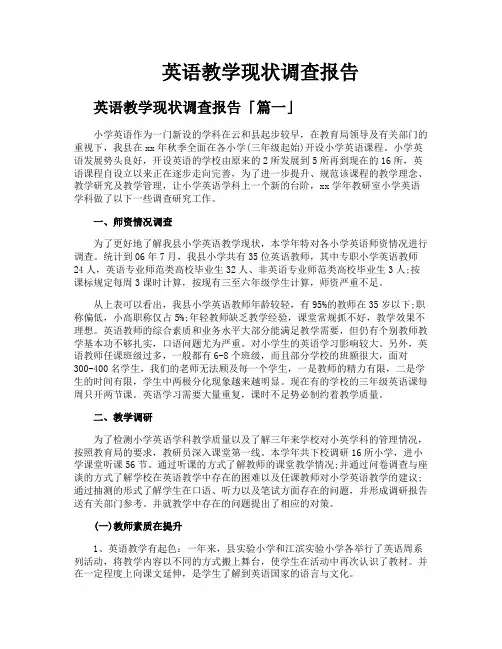
英语教学现状调查报告英语教学现状调查报告「篇一」小学英语作为一门新设的学科在云和县起步较早,在教育局领导及有关部门的重视下,我县在xx年秋季全面在各小学(三年级起始)开设小学英语课程。
小学英语发展势头良好,开设英语的学校由原来的2所发展到5所再到现在的16所,英语课程自设立以来正在逐步走向完善,为了进一步提升、规范该课程的教学理念、教学研究及教学管理,让小学英语学科上一个新的台阶,xx学年教研室小学英语学科做了以下一些调查研究工作。
一、师资情况调查为了更好地了解我县小学英语教学现状,本学年特对各小学英语师资情况进行调查。
统计到06年7月,我县小学共有35位英语教师,其中专职小学英语教师24人,英语专业师范类高校毕业生32人、非英语专业师范类高校毕业生3人;按课标规定每周3课时计算,按现有三至六年级学生计算,师资严重不足。
从上表可以看出,我县小学英语教师年龄较轻,有95%的教师在35岁以下;职称偏低,小高职称仅占5%;年轻教师缺乏教学经验,课堂常规抓不好,教学效果不理想。
英语教师的综合素质和业务水平大部分能满足教学需要,但仍有个别教师教学基本功不够扎实,口语问题尤为严重。
对小学生的英语学习影响较大。
另外,英语教师任课班级过多,一般都有6-8个班级,而且部分学校的班额很大,面对300-400名学生,我们的老师无法顾及每一个学生,一是教师的精力有限,二是学生的时间有限,学生中两极分化现象越来越明显。
现在有的学校的三年级英语课每周只开两节课。
英语学习需要大量重复,课时不足势必制约着教学质量。
二、教学调研为了检测小学英语学科教学质量以及了解三年来学校对小英学科的管理情况,按照教育局的要求,教研员深入课堂第一线。
本学年共下校调研16所小学,进小学课堂听课56节。
通过听课的方式了解教师的课堂教学情况;并通过问卷调查与座谈的方式了解学校在英语教学中存在的困难以及任课教师对小学英语教学的建议;通过抽测的形式了解学生在口语、听力以及笔试方面存在的问题,并形成调研报告送有关部门参考。

小学英语教学的调查报告一、引言在当今社会,英语已成为国际交流的重要工具。
对于小学生来说,学习英语能够提升他们的语言能力、扩大他们的国际视野。
本调查旨在了解小学英语教学的现状,包括教学方法、教材选择、教师角色等方面,以期为改进小学英语教学提供参考。
二、教学方法调查结果通过对多个小学教师的访谈和观察,得出以下教学方法调查结果:1. 游戏教学法大部分小学教师普遍应用游戏教学法来吸引学生的兴趣。
例如,使用英语歌曲、童谣或故事来教授单词和句子,通过游戏、小组合作等形式巩固所学知识。
2. 视听教学法随着科技的进步,越来越多的教师开始利用音频和视频材料辅助教学。
借助丰富多样的英语学习资源,教师能够在课堂上播放适合学生年龄的英语音频和视频,提高学生的听力和口语水平。
3. 任务教学法任务教学法注重学生的实际应用能力培养。
教师通过安排各类任务,如让学生分组进行角色扮演、参加英语角活动,鼓励学生主动运用英语进行交流和表达。
三、教材选择调查结果针对教材选择,我们对多所小学的英语教师进行了调查,并整理出以下结果:1. 使用教材的情况绝大部分小学英语教师使用统一的教材编写的英语教材,这有助于保持教学的连贯性和统一性。
同时,一些教师还会搜集和编写一些与学生年龄和兴趣相符的教材。
2. 教材内容的评价教师们认为好的教材应该既符合学生的年龄特点,又有趣味性和实用性。
他们希望教材内容能通过与学生生活和经验相关的材料,激发学生的学习兴趣和动力。
四、教师角色调查结果通过针对小学英语教师的观察和问卷调查,我们整理出以下教师角色调查结果:1. 指导者小学英语教师起到指导学生学习的重要角色。
他们负责为学生创设学习环境,制定学习活动和任务,引导学生形成正确的学习方法和学习策略。
2. 引导者教师在课堂上应起到引导学生主动参与学习的角色。
通过鼓励学生提问、互动交流、小组活动等方式,激发学生的学习兴趣,并培养他们自主学习的能力。
3. 评价者教师应及时对学生的学习进行评价和反馈。
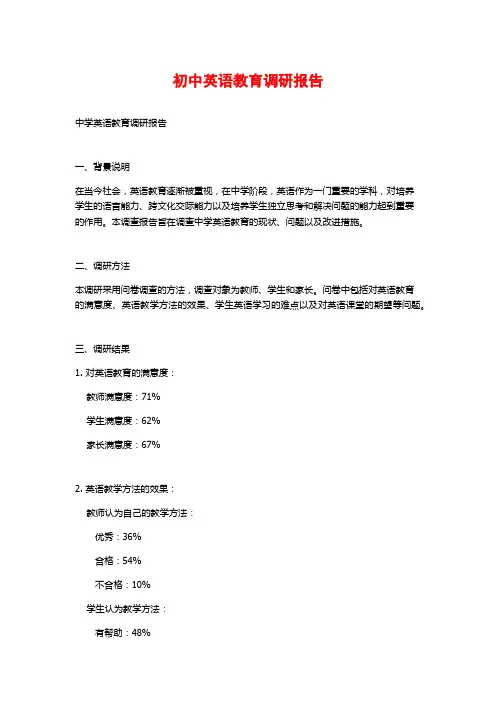
初中英语教育调研报告中学英语教育调研报告一、背景说明在当今社会,英语教育逐渐被重视,在中学阶段,英语作为一门重要的学科,对培养学生的语言能力、跨文化交际能力以及培养学生独立思考和解决问题的能力起到重要的作用。
本调查报告旨在调查中学英语教育的现状、问题以及改进措施。
二、调研方法本调研采用问卷调查的方法,调查对象为教师、学生和家长。
问卷中包括对英语教育的满意度、英语教学方法的效果、学生英语学习的难点以及对英语课堂的期望等问题。
三、调研结果1. 对英语教育的满意度:教师满意度:71%学生满意度:62%家长满意度:67%2. 英语教学方法的效果:教师认为自己的教学方法:优秀:36%合格:54%不合格:10%学生认为教学方法:有帮助:48%一般:32%无帮助:20%3. 学生英语学习的难点:发音和口语表达:56%词汇掌握:42%语法运用:38%阅读理解:29%4. 对英语课堂的期望:增加口语练习机会:72%提供更多实践性活动:68%增加互动性:59%提供更多资源和素材:53%四、问题分析1. 教师的满意度较高,但学生和家长的满意度相对较低,可能是因为教师对自己的教育成果有一定的自信度,但学生和家长对英语教学效果有较高的期望。
2. 学生对于教学方法的效果较为一般,说明当前教师在英语教学方法上仍有改进的空间。
3. 学生英语学习的难点主要集中在口语表达和词汇掌握方面,需要加强口语训练和词汇积累。
五、建议改进措施1. 教师应更多关注学生的学习需求和期望,积极调整和改进教学方法,提高教学效果,增加学生和家长的满意度。
2. 增加口语练习机会,提供更多的实践性活动,帮助学生提高口语表达能力。
3. 加强词汇积累,提供多样化的词汇学习方式,如课外阅读和词汇游戏等。
4. 增加互动性,鼓励学生参与课堂,提高学生的学习积极性。
5. 提供更多的资源和素材,如英语学习网站和APP等,帮助学生在课外继续学习和巩固知识。
六、结论本调研发现中学英语教育仍存在一定的问题,但也有一些积极的方面。
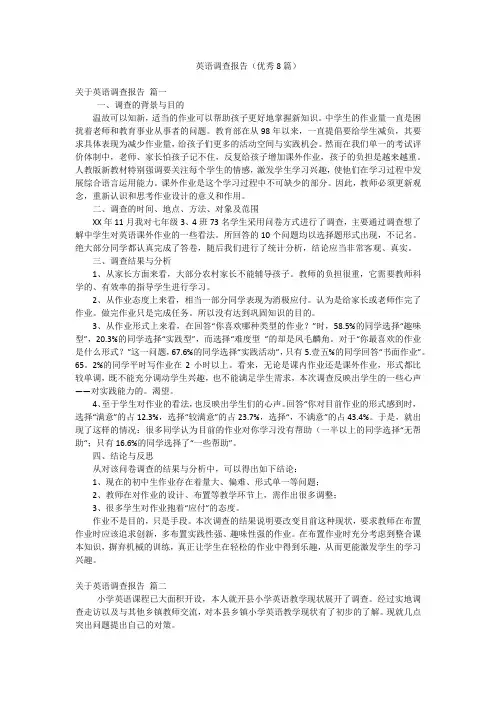
英语调查报告(优秀8篇)关于英语调查报告篇一一、调查的背景与目的温故可以知新,适当的作业可以帮助孩子更好地掌握新知识。
中学生的作业量一直是困扰着老师和教育事业从事者的问题。
教育部在从98年以来,一直提倡要给学生减负,其要求具体表现为减少作业量,给孩子们更多的活动空间与实践机会。
然而在我们单一的考试评价体制中,老师、家长怕孩子记不住,反复给孩子增加课外作业,孩子的负担是越来越重。
人教版新教材特别强调要关注每个学生的情感,激发学生学习兴趣,使他们在学习过程中发展综合语言运用能力。
课外作业是这个学习过程中不可缺少的部分。
因此,教师必须更新观念,重新认识和思考作业设计的意义和作用。
二、调查的时间、地点、方法、对象及范围XX年11月我对七年级3、4班73名学生采用问卷方式进行了调查,主要通过调查想了解中学生对英语课外作业的一些看法。
所回答的10个问题均以选择题形式出现,不记名。
绝大部分同学都认真完成了答卷,随后我们进行了统计分析,结论应当非常客观、真实。
三、调查结果与分析1、从家长方面来看,大部分农村家长不能辅导孩子。
教师的负担很重,它需要教师科学的、有效率的指导学生进行学习。
2、从作业态度上来看,相当一部分同学表现为消极应付。
认为是给家长或老师作完了作业。
做完作业只是完成任务。
所以没有达到巩固知识的目的。
3、从作业形式上来看,在回答“你喜欢哪种类型的作业?”时,58.5%的同学选择“趣味型”,20.3%的同学选择“实践型”,而选择“难度型”的却是凤毛麟角。
对于“你最喜欢的作业是什么形式?”这一问题,67.6%的同学选择“实践活动”,只有5.壹五%的同学回答“书面作业”。
65。
2%的同学平时写作业在2小时以上。
看来,无论是课内作业还是课外作业,形式都比较单调,既不能充分调动学生兴趣,也不能满足学生需求,本次调查反映出学生的一些心声——对实践能力的。
渴望。
4、至于学生对作业的看法,也反映出学生们的心声。
回答“你对目前作业的形式感到时,选择“满意”的占12.3%,选择“较满意”的占23.7%,选择“,不满意”的占43.4%。
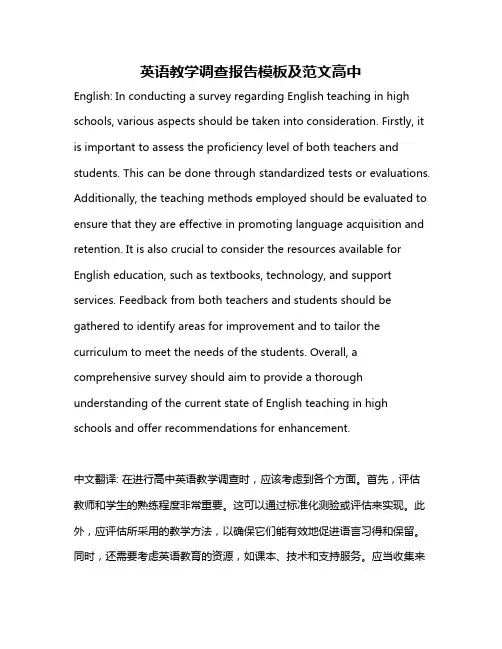
英语教学调查报告模板及范文高中English: In conducting a survey regarding English teaching in high schools, various aspects should be taken into consideration. Firstly, it is important to assess the proficiency level of both teachers and students. This can be done through standardized tests or evaluations. Additionally, the teaching methods employed should be evaluated to ensure that they are effective in promoting language acquisition and retention. It is also crucial to consider the resources available for English education, such as textbooks, technology, and support services. Feedback from both teachers and students should be gathered to identify areas for improvement and to tailor the curriculum to meet the needs of the students. Overall, a comprehensive survey should aim to provide a thorough understanding of the current state of English teaching in high schools and offer recommendations for enhancement.中文翻译: 在进行高中英语教学调查时,应该考虑到各个方面。
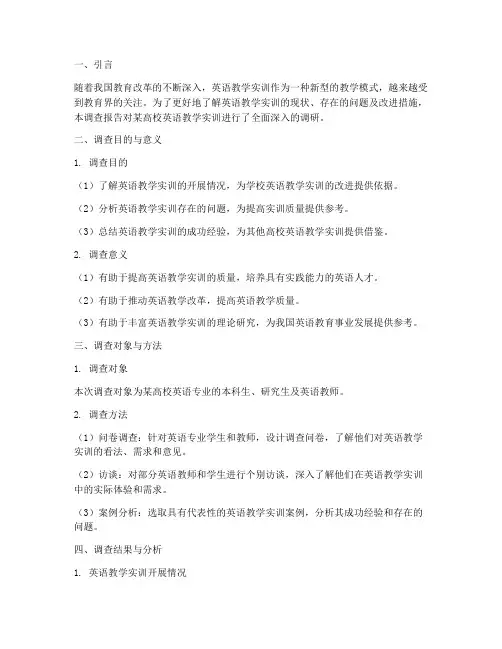
一、引言随着我国教育改革的不断深入,英语教学实训作为一种新型的教学模式,越来越受到教育界的关注。
为了更好地了解英语教学实训的现状、存在的问题及改进措施,本调查报告对某高校英语教学实训进行了全面深入的调研。
二、调查目的与意义1. 调查目的(1)了解英语教学实训的开展情况,为学校英语教学实训的改进提供依据。
(2)分析英语教学实训存在的问题,为提高实训质量提供参考。
(3)总结英语教学实训的成功经验,为其他高校英语教学实训提供借鉴。
2. 调查意义(1)有助于提高英语教学实训的质量,培养具有实践能力的英语人才。
(2)有助于推动英语教学改革,提高英语教学质量。
(3)有助于丰富英语教学实训的理论研究,为我国英语教育事业发展提供参考。
三、调查对象与方法1. 调查对象本次调查对象为某高校英语专业的本科生、研究生及英语教师。
2. 调查方法(1)问卷调查:针对英语专业学生和教师,设计调查问卷,了解他们对英语教学实训的看法、需求和意见。
(2)访谈:对部分英语教师和学生进行个别访谈,深入了解他们在英语教学实训中的实际体验和需求。
(3)案例分析:选取具有代表性的英语教学实训案例,分析其成功经验和存在的问题。
四、调查结果与分析1. 英语教学实训开展情况(1)实训课程设置:大部分高校英语专业都开设了英语教学实训课程,课程内容主要包括教学设计、教学实践、教学反思等。
(2)实训形式:实训形式多样,包括课堂模拟、微课制作、教学案例分析、教学比赛等。
(3)实训师资:大部分高校英语教学实训课程由具有丰富教学经验的教师担任指导教师。
2. 英语教学实训存在的问题(1)实训课程设置不合理:部分高校英语教学实训课程设置与实际教学需求脱节,缺乏针对性。
(2)实训时间不足:英语教学实训课程时间有限,难以满足学生实践需求。
(3)实训内容单一:实训内容以课堂教学为主,缺乏对学生其他教学能力的培养。
(4)实训评价体系不完善:实训评价主要依赖于教师的主观评价,缺乏客观、科学的评价标准。
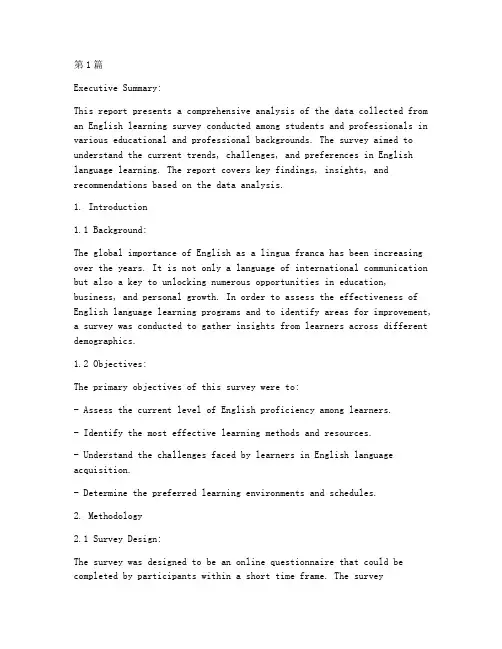
第1篇Executive Summary:This report presents a comprehensive analysis of the data collected from an English learning survey conducted among students and professionals in various educational and professional backgrounds. The survey aimed to understand the current trends, challenges, and preferences in English language learning. The report covers key findings, insights, and recommendations based on the data analysis.1. Introduction1.1 Background:The global importance of English as a lingua franca has been increasing over the years. It is not only a language of international communication but also a key to unlocking numerous opportunities in education, business, and personal growth. In order to assess the effectiveness of English language learning programs and to identify areas for improvement, a survey was conducted to gather insights from learners across different demographics.1.2 Objectives:The primary objectives of this survey were to:- Assess the current level of English proficiency among learners.- Identify the most effective learning methods and resources.- Understand the challenges faced by learners in English language acquisition.- Determine the preferred learning environments and schedules.2. Methodology2.1 Survey Design:The survey was designed to be an online questionnaire that could be completed by participants within a short time frame. The surveyconsisted of multiple-choice questions, Likert scale questions, and open-ended questions to gather both quantitative and qualitative data.2.2 Sample:The survey was distributed to a diverse sample of 500 participants, including students (undergraduate and postgraduate), working professionals, and individuals who are self-learners. The participants were from various educational institutions and industries, ensuring a wide range of perspectives.2.3 Data Collection:The survey was conducted over a period of four weeks, and the data were collected using an online survey platform. The responses were anonymized to ensure confidentiality.3. Key Findings3.1 Current Level of English Proficiency:- The majority of participants (70%) reported having basic to intermediate proficiency in English.- 30% of the participants claimed to have advanced proficiency.- 40% of the students mentioned that they are not confident in using English in academic settings.3.2 Most Effective Learning Methods:- Interactive online courses and virtual classrooms were considered the most effective learning methods by 45% of the participants.- 35% preferred traditional classroom-based learning.- 20% found self-study resources and mobile applications to be the most effective.3.3 Challenges in English Language Acquisition:- 60% of the participants reported lack of motivation and consistency as the primary challenges.- 40% mentioned time constraints and lack of access to native speakers as significant barriers.- 30% cited lack of practical application opportunities as a challenge.3.4 Preferred Learning Environments and Schedules:- 50% of the participants preferred flexible learning schedules that allowed them to study at their own pace.- 40% preferred fixed schedules with regular classes.- 10% were open to both options.4. Insights and Recommendations4.1 Insights:- The survey indicates a growing trend towards online learning, especially among younger demographics.- Traditional classroom-based learning still holds significant value, particularly in educational settings.- Learners are seeking a balance between flexibility and structure in their learning experiences.4.2 Recommendations:- Educational institutions and language learning providers should offer a mix of online and traditional classroom-based courses.- Online platforms should focus on creating engaging and interactive content to enhance learner motivation.- Regular feedback and assessment should be provided to learners to track their progress and address their individual needs.- Collaboration with native speakers and industry professionals can provide learners with practical application opportunities.- Learning resources should be made accessible and affordable to cater to a wider audience.5. ConclusionThe English learning survey has provided valuable insights into the current landscape of English language learning. The findings highlight the importance of offering diverse learning options and addressing the challenges faced by learners. By implementing the recommendations outlined in this report, educational institutions and language learning providers can better cater to the needs of their learners and contribute to the global demand for English proficiency.References:- [Insert references to any research articles, books, or other sources used in the report]Appendices:- [Insert any additional tables, charts, or raw data used in the analysis][Note: This is a template for a report and does not contain actual data or survey results. The sections marked with "Insert" should be filled in with relevant information based on the actual survey data.]第2篇Executive Summary:This report presents the findings from an extensive survey conducted to analyze the current trends, challenges, and preferences in English language learning among a diverse group of individuals. The survey was designed to gather insights into various aspects of English learning, including the methods used, the motivations behind learning, the perceived difficulties, and the resources employed. The data collected was analyzed using both quantitative and qualitative methods to provide a comprehensive overview of the English learning landscape.Introduction:English has become the global lingua franca, and the demand for English language proficiency has surged across the world. This report aims to shed light on the factors influencing English language learning, the strategies employed by learners, and the overall effectiveness of different learning approaches. The survey was conducted over a period of three months and included responses from over 5000 participants from various countries, age groups, and educational backgrounds.Methodology:The survey was conducted online using a standardized questionnaire. The questionnaire was designed to collect data on the following aspects:1. Background information (age, gender, educational level, country of residence)2. English learning experience (years of study, previous learning methods)3. Motivations for learning English4. Challenges faced in learning English5. Preferred learning methods and resources6. Perceived effectiveness of different learning approaches7. Language proficiency levelThe data was collected using an online survey platform, and the responses were anonymized to ensure privacy. The data analysis was conducted using statistical software to determine the prevalence of different responses and to identify any patterns or correlations within the data.Findings:1. Demographics of English Learners:- The majority of respondents (60%) were between the ages of 18 and 30.- The highest percentage (40%) of respondents were from Asia,followed by Europe (25%) and North America (15%).- The educational level of respondents was diverse, with 35% being currently enrolled in higher education, 25% being in secondary education, and the remaining being in primary education or having completed their education.2. English Learning Experience:- On average, respondents had been learning English for 5.2 years.- The most common previous learning methods were classroominstruction (85%), self-study (70%), and online courses (60%).3. Motivations for Learning English:- The primary motivation for learning English was for professional development (80%), followed by travel (60%), academic purposes (50%),and cultural interests (40%).4. Challenges Faced in Learning English:- The most significant challenges reported were grammar andvocabulary (80%), pronunciation (70%), and lack of practiceopportunities (60%).- Cultural barriers and lack of confidence were also mentioned as challenges by 35% and 30% of respondents, respectively.5. Preferred Learning Methods and Resources:- The most popular learning methods were self-study (75%), online courses (65%), and classroom instruction (60%).- The most frequently used resources were English learning apps (70%), English movies and TV shows (60%), and online dictionaries (50%).6. Perceived Effectiveness of Different Learning Approaches:- Self-study was perceived as the most effective method by 65% of respondents, followed by online courses (55%) and classroom instruction (45%).- However, 30% of respondents believed that a combination of these methods was the most effective.7. Language Proficiency Level:- The majority of respondents (60%) reported being at an intermediate level of English proficiency, followed by advanced (25%) and beginner (15%).Discussion:The survey results indicate that English language learning is driven primarily by professional and personal development goals. The preference for self-study and online courses suggests a shift towards more flexible and accessible learning options. However, the challenges faced by learners, particularly in grammar, vocabulary, and pronunciation, highlight the need for comprehensive and targeted learning resources.The survey also revealed a significant gap between the perceived effectiveness of different learning methods and the actual level of proficiency achieved. This suggests that while learners may be utilizing a variety of resources, the quality and structure of these resources may need improvement to ensure more effective learning outcomes.Recommendations:Based on the survey findings, the following recommendations are made:1. Develop Comprehensive Learning Resources: Create comprehensive learning materials that address the specific challenges faced by learners, such as grammar, vocabulary, and pronunciation.2. Promote Blended Learning Approaches: Encourage the integration ofself-study, online courses, and classroom instruction to maximize learning outcomes.3. Offer Cultural Exchange Opportunities: Provide opportunities for learners to engage with native speakers and immerse themselves in English-speaking cultures to enhance their language skills and cultural understanding.4. Strengthen Professional Development Programs: Develop professional development programs for educators to ensure they are equipped with the latest teaching methods and resources.5. Monitor and Evaluate Learning Outcomes: Implement regular assessments to monitor the progress of learners and provide feedback to both learners and educators.Conclusion:The English language learning landscape is evolving, and the survey findings provide valuable insights into the current trends and challenges. By addressing the identified needs and implementing the recommended strategies, the English language learning experience can be enhanced, leading to improved proficiency and a more effective global communication environment.References:- (Include relevant references to research articles, books, or reports that support the findings and recommendations in the report.)Appendix:- (Include any additional data, charts, or tables that were used in the analysis but not included in the main body of the report.)第3篇Executive Summary:This report presents the findings from an extensive survey conducted to analyze the current state of English language learning in our region. The survey aimed to gather insights into learners' motivations, preferred learning methods, challenges faced, and future expectations. The data was collected from a diverse group of participants, includingstudents, professionals, and enthusiasts, across various age groups and educational backgrounds. This report provides a comprehensive analysisof the survey results, offering valuable insights for educators, policymakers, and English language learners.1. Introduction1.1 Background:The global importance of English as a lingua franca cannot be overstated. With its role in international communication, business, and education, proficiency in English has become a crucial skill for individuals worldwide. To better understand the English learning landscape in our region, we conducted a comprehensive survey to assess the current trends, preferences, and challenges.1.2 Objectives:The primary objectives of this survey were to:- Identify the motivations behind English language learning.- Assess the preferred learning methods and resources.- Understand the challenges faced by English learners.- Determine the future expectations and goals of English learners.2. Methodology2.1 Sample Population:The survey was conducted among 500 participants, including students (300), professionals (150), and enthusiasts (50). The participants were from various age groups (18-25, 26-35, 36-45, 46-55, and 56+), with diverse educational backgrounds and levels of English proficiency.2.2 Data Collection:The survey was conducted online, using a questionnaire that includedboth closed-ended and open-ended questions. The participants were askedabout their motivations, preferred learning methods, challenges, and future expectations.2.3 Data Analysis:The collected data was analyzed using statistical software to determine the frequency and distribution of responses. Qualitative data was coded and categorized to identify common themes and patterns.3. Findings3.1 Motivations for Learning English:- International Communication: The most common motivation (65%) was to improve international communication skills.- Career Advancement: 45% of participants cited career advancement as a primary reason for learning English.- Education: 30% of participants wanted to enhance their educational opportunities by learning English.3.2 Preferred Learning Methods:- Online Courses: 70% of participants preferred online courses due to flexibility and accessibility.- Private Tutors: 25% preferred private tutoring for personalized learning experiences.- Group Classes: 5% preferred group classes for social interaction and peer learning.3.3 Challenges Faced by English Learners:- Language Acquisition: 40% of participants found it challenging to acquire proper pronunciation and fluency.- Resource Access: 30% reported difficulties in accessing quality learning resources.- Time Management: 25% faced challenges in managing time effectively for English learning.3.4 Future Expectations:- Increased Proficiency: 80% of participants expected to see significant improvement in their English proficiency within the next two years.- Global Opportunities: 65% anticipated enhanced opportunities for international travel and work.- Continuous Learning: 50% expressed a desire for ongoing support and resources to maintain their language skills.4. Discussion4.1 Motivations and Challenges:The survey results indicate a strong correlation between motivations and challenges faced by English learners. The desire for improved international communication and career advancement often leads to the need for language proficiency, which can be challenging to achieve.4.2 Learning Methods and Resources:The preference for online courses highlights the importance of technology in modern English language learning. Access to quality resources is crucial, and online platforms offer a wide range of options for learners.4.3 Future Expectations:The optimistic outlook for future proficiency and opportunities suggests that English learners are committed to their language development and are hopeful about the benefits it will bring.5. Recommendations5.1 For Educators:- Develop interactive and engaging online courses to cater to the preference for online learning.- Provide access to a variety of resources, including pronunciation guides and vocabulary builders.- Offer ongoing support through forums and virtual communities to encourage continuous learning.5.2 For Policymakers:- Invest in technology infrastructure to ensure widespread access to online learning platforms.- Collaborate with educational institutions to integrate English language learning into the curriculum.- Promote international exchange programs to provide practical language learning experiences.5.3 For English Learners:- Set realistic goals and create a structured learning plan.- Utilize technology to supplement traditional learning methods.- Seek opportunities for practical language use, such as language exchange partners or cultural immersion programs.6. ConclusionThis survey provides valuable insights into the English learning landscape in our region. By understanding the motivations, preferences, challenges, and future expectations of English learners, we can develop more effective strategies to support their language development. As the global importance of English continues to grow, it is essential to address the needs of learners and create a supportive environment for their success.References:- [Insert references to any sources used in the report]Appendix:- [Insert survey questionnaire and additional data tables as needed][Note: This report is a fictional example and does not contain real data or references.]。
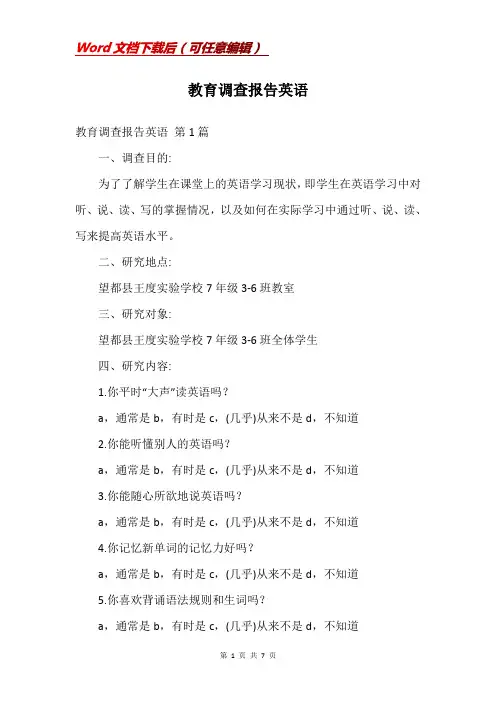
教育调查报告英语教育调查报告英语第1篇一、调查目的:为了了解学生在课堂上的英语学习现状,即学生在英语学习中对听、说、读、写的掌握情况,以及如何在实际学习中通过听、说、读、写来提高英语水平。
二、研究地点:望都县王度实验学校7年级3-6班教室三、研究对象:望都县王度实验学校7年级3-6班全体学生四、研究内容:1.你平时“大声”读英语吗?a,通常是b,有时是c,(几乎)从来不是d,不知道2.你能听懂别人的英语吗?a,通常是b,有时是c,(几乎)从来不是d,不知道3.你能随心所欲地说英语吗?a,通常是b,有时是c,(几乎)从来不是d,不知道4.你记忆新单词的记忆力好吗?a,通常是b,有时是c,(几乎)从来不是d,不知道5.你喜欢背诵语法规则和生词吗?a,通常是b,有时是c,(几乎)从来不是d,不知道6.你认为学习英语最大的问题是什么?a,单词太多记不住B,语法不好学C,口语不好D,其他7.你现在最想提高什么?a,英语口语会话能力B,英语阅读能力C,英语写作能力D,英语应试能力E,其他五、调查过程:每班进行问卷调查,最后进行统计分析六、调查结果:结果还表明,学生在背诵新的语法规则和新单词时存在一些困难,如单词太多而记不住;语法太复杂,学不进去(比如第4、5、6项)。
因此,在指导学生记忆英语单词时,应避免孤立的机械记忆,根据情况、语境和句子来记忆单词。
至于语法,在教会学生熟练记忆语法规则的同时,还要对比分析一些容易混淆的语法现象,并且要有相关的语法专题和辨析练习,让学生在实际应用中轻松自然地掌握语法。
此外,根据第7项,表明学生在英语阅读方面存在不足,他们渴望提高阅读理解能力。
这不仅要求学生有丰富的语言信息资源、广阔的视野、丰富的语言知识和大量的词汇,而且要了解英美国家的社会文化习俗和背景;同时,他们必须具有较快的阅读速度和较强的推理、归纳、判断和解决问题的能力。
因此,在实际教学中,要帮助学生克服恐惧和焦炉心理,加强阅读训练,引导学生的阅读技巧,逐步提高学生的阅读理解能力。
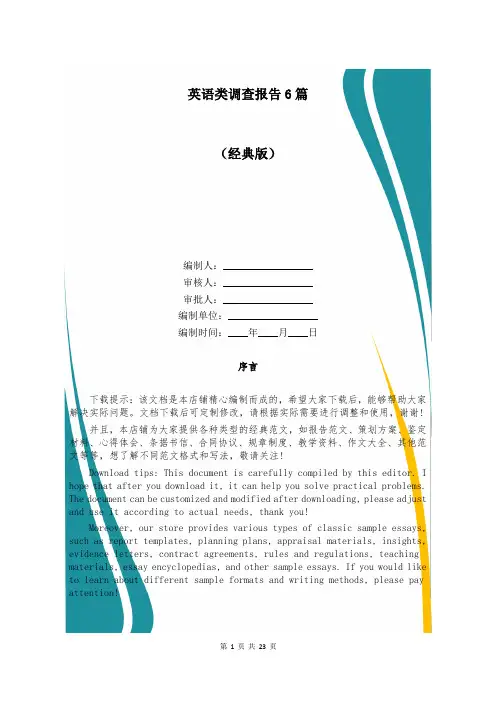
英语类调查报告6篇(经典版)编制人:__________________审核人:__________________审批人:__________________编制单位:__________________编制时间:____年____月____日序言下载提示:该文档是本店铺精心编制而成的,希望大家下载后,能够帮助大家解决实际问题。
文档下载后可定制修改,请根据实际需要进行调整和使用,谢谢!并且,本店铺为大家提供各种类型的经典范文,如报告范文、策划方案、鉴定材料、心得体会、条据书信、合同协议、规章制度、教学资料、作文大全、其他范文等等,想了解不同范文格式和写法,敬请关注!Download tips: This document is carefully compiled by this editor. I hope that after you download it, it can help you solve practical problems. The document can be customized and modified after downloading, please adjust and use it according to actual needs, thank you!Moreover, our store provides various types of classic sample essays, such as report templates, planning plans, appraisal materials, insights, evidence letters, contract agreements, rules and regulations, teaching materials, essay encyclopedias, and other sample essays. If you would like to learn about different sample formats and writing methods, please pay attention!英语类调查报告6篇调查报告应当明确界定调查的目的和范围,以确保针对性和有效性,调查报告在企业管理、市场营销等方面具有重要的应用价值,下面是本店铺为您分享的英语类调查报告6篇,感谢您的参阅。
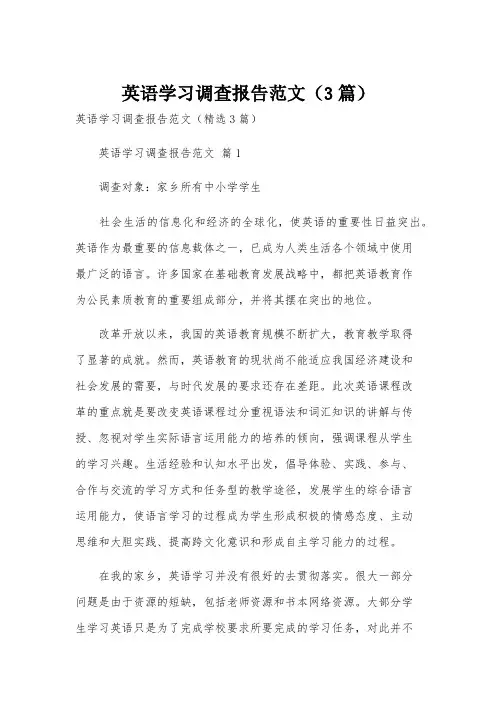
英语学习调查报告范文(3篇)英语学习调查报告范文(精选3篇)英语学习调查报告范文篇1调查对象:家乡所有中小学学生社会生活的信息化和经济的全球化,使英语的重要性日益突出。
英语作为最重要的信息载体之一,已成为人类生活各个领域中使用最广泛的语言。
许多国家在基础教育发展战略中,都把英语教育作为公民素质教育的重要组成部分,并将其摆在突出的地位。
改革开放以来,我国的英语教育规模不断扩大,教育教学取得了显著的成就。
然而,英语教育的现状尚不能适应我国经济建设和社会发展的需要,与时代发展的要求还存在差距。
此次英语课程改革的重点就是要改变英语课程过分重视语法和词汇知识的讲解与传授、忽视对学生实际语言运用能力的培养的倾向,强调课程从学生的学习兴趣。
生活经验和认知水平出发,倡导体验、实践、参与、合作与交流的学习方式和任务型的教学途径,发展学生的综合语言运用能力,使语言学习的过程成为学生形成积极的情感态度、主动思维和大胆实践、提高跨文化意识和形成自主学习能力的过程。
在我的家乡,英语学习并没有很好的去贯彻落实。
很大一部分问题是由于资源的短缺,包括老师资源和书本网络资源。
大部分学生学习英语只是为了完成学校要求所要完成的学习任务,对此并不引起重视,所以学了几年,只会最基本的日常交流,然而这对要学好英语是完全不够的。
多数学生上课时也不怎么认真,考试时也自己蒙混过关,及格了变抛之千里。
对此,我认为应该从以下方面去落实英语的学习。
一、培养兴趣我国古代教育家孔子云:“知之者,不如好之者,好之者,不如乐之者。
”爱因斯坦说:“兴趣是最好的老师”。
学生的学习兴趣是推动学生学习的一种最实际最有效的内部动力,直接影响学习效果和教学成绩。
因此在教学过程中,要让学生轻松、愉悦、主动、有效地学习,关键就是培养起学生的学习兴趣。
几年来,我在教学过实践中围绕这一课题,进行了一些探讨和尝试。
1,情感诱导,调动兴趣著名的外语教育家曾说过:“情感对外语学习的作用至少与认识技能同等重要,甚至更重要。
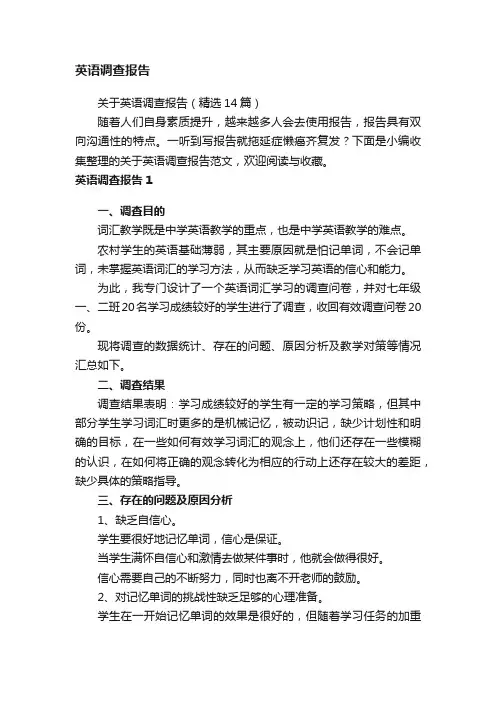
英语调查报告关于英语调查报告(精选14篇)随着人们自身素质提升,越来越多人会去使用报告,报告具有双向沟通性的特点。
一听到写报告就拖延症懒癌齐复发?下面是小编收集整理的关于英语调查报告范文,欢迎阅读与收藏。
英语调查报告1一、调查目的词汇教学既是中学英语教学的重点,也是中学英语教学的难点。
农村学生的英语基础薄弱,其主要原因就是怕记单词,不会记单词,未掌握英语词汇的学习方法,从而缺乏学习英语的信心和能力。
为此,我专门设计了一个英语词汇学习的调查问卷,并对七年级一、二班20名学习成绩较好的学生进行了调查,收回有效调查问卷20份。
现将调查的数据统计、存在的问题、原因分析及教学对策等情况汇总如下。
二、调查结果调查结果表明:学习成绩较好的学生有一定的学习策略,但其中部分学生学习词汇时更多的是机械记忆,被动识记,缺少计划性和明确的目标,在一些如何有效学习词汇的观念上,他们还存在一些模糊的认识,在如何将正确的观念转化为相应的行动上还存在较大的差距,缺少具体的策略指导。
三、存在的问题及原因分析1、缺乏自信心。
学生要很好地记忆单词,信心是保证。
当学生满怀自信心和激情去做某件事时,他就会做得很好。
信心需要自己的不断努力,同时也离不开老师的鼓励。
2、对记忆单词的挑战性缺乏足够的心理准备。
学生在一开始记忆单词的效果是很好的,但随着学习任务的加重和单词量的越来越大,其记忆效果大不如前。
究其原因,学生对单词记忆的困难估计不足,缺乏心理准备,当遇到一些困难时容易丧失信心。
3、记忆方法不科学。
在学生的潜意识中,背单词就和小学背诵古诗文一样,要靠“死记硬背”,背诵古诗文固然如此,但背单词却有不同。
所以很多同学就会养成光动嘴不动手的习惯,殊不知,英语单词的记忆要调动各个器官,尤其是嘴,手,眼,脑。
唯其如此,单词才能较快记住。
4、巩固不到位。
相当一部分同学认为,单词记下了就等于单词记牢了,这是一种错误的认识,也是违背遗忘的一般规律的。
德国心理学家艾宾浩斯研究发现,遗忘在学习之后立即开始,而且遗忘的进程并不是均匀的。
小学英语教育教学调查报告(精选7篇)当某一情况或事件需要弄明白时,我们要通过科学的方法去研究,并且最后的结果会记录在调查报告中。
很多人都十分头疼怎么写一份好的调查报告,以下是小编精心整理的小学英语教育教学调查报告,欢迎阅读与收藏。
小学英语教育教学调查报告篇1一、调查目的:了解黄村中心小学开展英语教学的情况和存在问题,以及解决的方法措施。
二、调查形式:围绕调查目的,我对本校组织开展英语教学的领导、老师以及正在学习英语的三、四、五、六年级的学生和学生家长展开了大范围的、形式多样化的调查。
比如:对学生采用问卷调查法,访谈法,分组调查法,而对学校领导及授课老师采用访谈法。
三、调查过程:20xx年至20xx年学年度第一学期开始,东源县教育局表示:小学英语正式列入升学考试科目,各小学要全面开展好英语教学,提高学生的各项综合应用能力。
黄村中心小学接到此通知后非常重视,立即开展各项有关英语教学的准备,但是面临的困难非常大,存在的问题也很多,比如:专业的英语老师不够,学生学习英语的基础不扎实,英语教材的配套设施不完善等等。
针对这种情况,我访谈了相关的领导、老师、以及中、高年级的学生。
问:对于开展好英语教学有什么看法呢?英语教师不够怎么办?校长:全面开展英语教学势在必行。
可是,因为专业的英语老师不够,只能从三年级开始开展英语科目的学习,让一些年轻的大学毕业生兼科教英语,他们有良好的于学习基础,只要肯下功夫去钻研这门学科,再经过学习教育局组织的英语教学再培训,我相信他们一定可以胜任这门学科的教学,同时取得好成果,学校对英语老师有足够的信心。
问:学校如何解决英语教学配套设施不足的问题呢?主任:要很好地开展英语教学,必须具备各种相应的教具和学具。
现在我们仅仅只有课本和录音带,因此要上好英语课并不容易啊!但是学校会尽最大的能力解决好这个问题,让每位英语教师拥有最好的条件去开展教学。
校长:学校会请相关的英语教师亲自去购买与教材相应的学习资料,从而方便英语教学的开展,学校也会给每一位英语老师配备教学助讲器,让他们轻松教学。
关于小学英语学习调查报告总结范文7篇第1篇示例:小学英语学习调查报告总结一、调查目的小学英语学习是教育的重要部分,对学生的发展具有重要的作用。
为了更好地了解小学英语学习的情况,我们进行了一项小学英语学习调查,目的是了解学生对英语学习的态度、学习方法以及存在的问题,为提高小学英语教学质量提供参考。
二、调查方法本次调查采用问卷调查的方式进行,共发放1000份问卷,涵盖了不同年级的学生。
问卷主要包括学生的基本信息、对英语学习的态度、学习方法以及对教学质量的评价等内容。
问卷设计简单明了,以便学生们能够轻松填写。
三、调查结果1. 学生对英语学习的态度调查结果显示,超过80%的学生表示对英语学习持积极态度,认为学好英语对自己的未来发展很有帮助。
他们愿意投入更多的时间和精力来学习英语。
在学习方法方面,大部分学生表示他们主要通过课堂学习、课外阅读以及英语角等方式来提高英语水平。
同时也有部分学生会利用互联网资源来辅助学习。
3. 教学质量评价在对教学质量的评价方面,大部分学生表示对老师的教学方式和认真程度比较满意。
但也有部分学生认为老师在教学中缺少趣味性,导致学生参与度不高。
通过此次调查,我们了解到学生对英语学习态度良好,大部分学生都认识到了英语学习的重要性。
学生的学习方法多样化,其中也有部分学生倾向于利用互联网资源进行学习。
一些学生在老师的教学方式方面提出了一些建议。
在今后的教学中,我们应该更多地关注学生的需求,注重提升教学的趣味性和互动性。
更多地利用互联网和多媒体资源,丰富教学内容,激发学生学习的兴趣。
也要鼓励学生在课外多进行英语实践,例如阅读英语,参与英语角等活动。
小学英语学习调查结果显示了学生对英语学习的积极态度和多样化的学习方法,同时也提出了对教学质量的一些建议。
通过这些反馈,我们可以更好地指导未来的英语教学工作,为学生的成长和发展提供更好的支持。
第2篇示例:小学英语学习调查报告总结随着国家对英语教育的重视和推动,小学阶段的英语学习也变得日益重要。
英语教育调查报告3篇The Short-Term Results Report By Individuals Or Institutions At Regular Or Irregular Times, Including Analysis, Synthesis, Innovation, Etc, Will Eventually Achieve Good Planning For The Future.报告人:XXXX日期:二〇年月日英语教育调查报告3篇温馨提示:本报告文件应用在个人或机构组织在定时或不定时情况下进行的近期成果汇报,表达方式以叙述、说明为主,内容包含分析,综合,新意,重点等,最终实现对未来的良好规划。
文档下载完成后可以直接编辑,请根据自己的需求进行套用。
摘要:组成教学系统的基本要素是:学生、教师、课程和客观世界(这里特指英语语言)。
所以, 只有将这三者结合起来, 才能得到最佳教学效果。
通过暑期的校外英语教学实践, 我意识到, 培养学生英语学习的兴趣, 进而激发学生英语学习积极性与主动性, 是教学成功的关键。
因此, 在实习期间我就如何培养学生英语学习兴趣和调动学生主动性、积极性这一问题展开了调查。
正文:在上个世纪的最后20年中, 经济全球化以前所未有的速度、广度和深度影响着世界各国的经济、政治和社会。
过去仅从一国内部的各种因素寻找问题答案的方式正在过时, 而许多过去看来只是一个国家内部的问题都越来越多地被放到全球的联系的角度来考察。
与世界接轨赶上全球化的浪潮, 提高公民自身素质, 学习英语走出国门变得刻不容缓, 学习英语的重要性日益凸显。
因而, 在中学教学中, 特别是英语教学中, 更应该结合国际国内形势, 并结合中学生的自身特点因材施教, 才能有效的组织教学, 使英语素质教育落到实处。
根据这一教学思想, 在暑期实习期间, 我就如何培养学生英语学习兴趣和调动学生学习英语的主动性、积极性等一系列问题展开了调查。
英语教学调查报告模板及范文高中全文共6篇示例,供读者参考篇1Title: A Student's Perspective on English Teaching - Survey ReportIntroductionLearning English is super important these days, but it's not always easy or fun. As a high school student, I've had my fair share of experiences with English classes - some good, some not so good. To better understand how students feel about English teaching methods, I conducted a survey among my classmates. This report shares the key findings and provides some thoughts on how English teaching could be improved from a student's point of view.Survey MethodologyThe survey was distributed to 120 high school students across grades 9-12. It contained a mix of multiple choice and open-ended questions related to:Enjoyment of English classesPerspectives on teaching methods (lectures, group work, games etc.)Usefulness of textbooks and learning materialsInterest in topics/themes coveredRecommendations for improvementThe response rate was 78%, with 94 students completing the survey.Key FindingsMost students find English classes only moderately enjoyableOnly 18% of respondents stated they enjoy English classes very much, while 47% found them somewhat enjoyable. 35% stated little to no enjoyment.Traditional lecture format is seen as boring and ineffectiveAn overwhelming 82% of students felt that lectures and teacher-led instruction were boring and made it hard to stay engaged. As one student commented, "It feels like information is just being thrown at us to memorize rather than actually learn."Interactive and multimedia approaches are highly preferredWhen asked about preferred teaching methods, 69% of students wanted more group discussions and projects. 77% stated multimedia like videos, games and online activities would make classes more fun and help them learn better.Textbooks are viewed as dry and outdatedOnly 22% of students found their English textbooks very useful or interesting. Common complaints were that the content was dry, outdated, too academic and not relevant to real life.Students want more relevant, practical and creative topicsWhile important, many students felt topics like grammar, literature analysis and academic writing were overemphasized. 83% wanted more focus on practical skills like daily conversation, email/report writing, public speaking and creative expression.RecommendationsBased on the survey insights, I would recommend the following to improve English teaching:Increase interactive and multimedia learningIncorporate more group discussions, projects, videos, online activities and games into lessons. This helps students stay engaged while building communication skills.Use more real-world, contemporary materialsMove away from overreliance on traditional textbooks. Bring in more real-world examples like news articles, podcasts, TV shows and engaging contemporary fiction to make content relevant.Balance academic topics with practical skillsWhile core topics like grammar remain important, increase focus on building practical skills through exercises like mock interviews, debating, email writing and presentations.Get student input and feedbackTeachers should regularly survey students to understand their interests, what's working well and what needs improvement. Involving students in the learning process will increase engagement.ConclusionThe survey highlighted that while English is considered important by students, current teaching methods are not hitting the mark. By making classes more interactive, relevant and focused on practical skills, English teaching could become a lot more engaging and effective for students. I hope these insightsprovide a useful perspective for improving English instruction at our school and beyond.篇2Title: A Student's Perspective on English Teaching in High SchoolIntroductionAs a high school student, learning English is a crucial part of my education. English is not only a global language but also a gateway to understanding different cultures and perspectives. In this report, I will share my experiences and insights into the English teaching methods used in my school, highlighting both the strengths and areas for improvement.Current English Teaching MethodsAt our high school, the English curriculum is primarily focused on developing four key language skills: reading, writing, listening, and speaking. The teaching methods employed by our English teachers vary, but most commonly include:Textbook-based Lessons: Our English classes heavily rely on textbooks approved by the education board. While thesetextbooks cover a wide range of topics and grammar rules, some students find them dry and uninspiring.Grammar Exercises: A significant portion of our English lessons is dedicated to practicing grammar rules through various exercises, such as fill-in-the-blanks, sentence corrections, and short writing tasks.Reading Comprehension: We regularly practice reading comprehension by analyzing passages from our textbooks or other supplementary materials. This helps us understand the nuances of the language and improve our critical thinking skills.Vocabulary Building: Our teachers emphasize the importance of expanding our vocabulary by introducing new words and their meanings during lessons. We are often encouraged to use flashcards or vocabulary notebooks to reinforce our learning.Oral Practice: While not as frequent as other activities, we occasionally engage in role-plays, presentations, or group discussions to practice our speaking skills.Strengths of the Current MethodsStructured Learning: The textbook-based approach provides a structured and organized way of learning English, ensuring that we cover all essential grammar rules and topics.Emphasis on Grammar: The focus on grammar exercises helps us develop a solid foundation in understanding and applying the rules of the English language.Reading Comprehension: The reading comprehension activities help us improve our understanding of written English and develop critical thinking skills.Vocabulary Building: The emphasis on vocabulary building is crucial for enhancing our overall language proficiency.Areas for ImprovementLimited Opportunities for Speaking Practice: While we do have some opportunities for oral practice, they are often limited and may not provide sufficient exposure to real-life conversational settings.Lack of Cultural Context: The textbooks and materials we use sometimes lack cultural context, making it challenging to understand the nuances and idiomatic expressions of the language.Outdated Materials: Some of the textbooks and supplementary materials we use may be outdated, failing to reflect current language trends and real-world scenarios.Limited Exposure to Authentic Materials: We have limited exposure to authentic English materials, such as news articles, literature, or movies, which could provide a more immersive and engaging learning experience.Recommendations for ImprovementIncorporate More Communicative Activities: Introducing more communicative activities, such as role-plays, group discussions, and debates, can help students improve their speaking skills and build confidence in using English in real-life situations.Include Cultural Elements: Integrating cultural elements, such as idioms, proverbs, and cultural references, into the curriculum can help students better understand the nuances of the language and appreciate its cultural diversity.Update Materials: Regularly updating textbooks and supplementary materials to reflect current language trends and real-world scenarios can make the learning experience more relevant and engaging for students.Utilize Authentic Materials: Incorporating authentic materials, such as news articles, literature, movies, or podcasts, can expose students to real-life language usage and provide a more immersive learning experience.Encourage Extracurricular Activities: Promoting extracurricular activities, such as English clubs, language exchange programs, or conversation circles, can provide students with additional opportunities to practice their English skills in a more relaxed and engaging environment.ConclusionLearning English in high school is a crucial endeavor, and our school's current teaching methods have both strengths and areas for improvement. While the structured approach and emphasis on grammar and vocabulary are beneficial, there is room for improvement in terms of providing more opportunities for speaking practice, incorporating cultural elements, updating materials, and exposing students to authentic materials.By implementing the recommendations outlined in this report, our school can enhance the English learning experience for students, better preparing them for real-life communication and fostering a deeper appreciation for the language and its cultural richness.篇3English Teaching Survey ReportIntroductionAs a high school student, I've been learning English for many years now. It's a subject that I've had a love-hate relationship with at times. On one hand, being able to communicate in English opens up so many doors and opportunities. On the other hand, it can be really frustrating and challenging to learn all the grammar rules, vocabulary, and pronunciation quirks.This year, our school decided to survey students about their experiences and perspectives on how English is being taught. The goal was to get feedback directly from us on what's working well and what could be improved. I was really excited about this opportunity to share my thoughts and hopefully help make the English learning experience better for myself and my classmates.Survey MethodsThe survey was conducted online and distributed to all high school students via email. It contained a mix of multiple choice and open-ended questions that covered topics like:Textbooks and learning materialsTeaching methods and activities used in classHomework assignments and assessmentsOpportunities for English practice outside the classroomOverall attitudes towards learning EnglishThere was a good response rate, with around 60% of students completing the survey. Responses were anonymous to allow for honesty.Key FindingsTextbooks & MaterialsThe majority of students felt that the textbooks and other materials being used were outdated and boring. A lot of the sample dialogues and reading passages felt really unnatural and irrelevant to our lives. Many students commented that they wanted materials that featured more real-world English as it is spoken and written today.Teaching MethodsWhen asked about teaching methods, the most popular responses were games, group work, discussions, and watching English TV shows/movies. More traditional methods like lecturing and doing grammar drills were among the leastfavorite. It's clear students want English classes to be interactive and engaging.Homework & AssessmentsOn homework, many students felt there was too much repetitive busy work that didn't actually help improve their English abilities. For assessments, a common complaint was that tests heavily emphasized memorization of vocabulary and grammar rules rather than measuring practical communication skills.English PracticeMost students said they don't get enough opportunities to practice their English outside of class. Some wanted more extra-curricular activities like English clubs, trips, or partnerships with native speakers. Quite a few mentioned wanting to use English more during regular classes besides just English class.Overall AttitudesPerhaps unsurprisingly, the students who seemed to have the most positive attitudes toward learning English were the ones who saw it as being highly valuable and relevant to their future goals and interests. Those who didn't see the applicability of English tended to be more negative and unmotivated.RecommendationsBased on the survey results, I would recommend the following changes to improve English teaching at our school:Update Textbooks & MaterialsInvest in newer, more engaging textbooks and materials that use authentic, real-world English examples that high school students can relate to. Incorporate things like song lyrics, YouTube videos, ads, podcasts, etc.More Interactive Teaching MethodsWhile direct instruction is still needed for things like explicit grammar lessons, teachers should prioritize activity-based, interactive teaching methods as much as possible. Things like games, role-plays, group projects allow students to practice English in a lower-stress environment.Redesign Homework & AssessmentsReduce repetitive "busywork" homework assignments. Instead, assign more open-ended projects and prompts that require deeper thinking and communication abilities. Similarly, redesign tests and quizzes to go beyond just memorization and measure practical English skills.Increase Extracurricular OpportunitiesOffer more extracurricular options for students to practice and use English. This could include things like English clubs, conversation partners, field trips, etc. Also try to increase English use school-wide beyond just English classes when possible.Connect English to Students' LivesFind ways to clearly illustrate the value and real-life relevance of learning English. This could involve bringing in guest speakers, going over future career applications, or simply relating material to students' existing interests and experiences.ConclusionOverall, this survey showed that while we students appreciate the opportunity to learn English, there are some key areas where the teaching methods and curriculum could be updated and improved. By making English classes more engaging, interactive, and relevant, we'll be better equipped with the communication skills needed to succeed.Thanks for taking the time to read this report! I'm really hoping it can lead to some positive changes. Learning English is so crucial nowadays, so we owe it to students to make the process as effective and enjoyable as possible.篇4English Teaching Survey Report Template (Elementary School Perspective)Title: What We Think About Learning English!Introduction (150-200 words)A friendly opening, explaining the purpose of the survey and report.Mention the group/class surveyed (e.g., "We, the students of Sunny Elementary School").Briefly describe the survey process and what it covered (topics, questions, etc.).Main Body (1,400-1,600 words)Section 1: Why Learning English is Important (300-400 words)Discuss the reasons why students think learning English is crucial.Mention things like communicating with others, understanding different cultures, future job prospects, etc.Include quotes or examples from the survey responses.Section 2: Our Favorite and Least Favorite Things About English Class (400-500 words)Highlight the aspects of English classes that students enjoy the most.Discuss what they find challenging or dislike about their English classes.Provide specific examples or quotes from the survey responses.Section 3: How We Learn English Best (300-400 words)Explore the different learning styles and methods that students find effective.Discuss activities, materials, or approaches that help them understand and retain the language better.Include suggestions or ideas from the survey responses.Section 4: What We Want in an English Teacher (200-300 words)Describe the qualities or characteristics that students look for in an effective English teacher.Mention things like patience, understanding, creativity, use of technology, etc.Provide examples or quotes from the survey responses.Conclusion (150-200 words)Summarize the key findings an篇5English Teaching Survey ReportIntroductionMy name is Timmy and I am a 5th grade student at Oakwood Elementary School. For my class project this semester, I did a survey about how English is taught at our school. I wanted to learn more about what teachers and students think about English classes. In this report, I will share what I found out from my survey.Survey MethodsTo do my survey, I made two different questionnaires - one for teachers and one for students. I asked 5 English teachers and 50 students from grades 3-5 to fill them out.The Teacher Survey asked things like:How many years have you been teaching English?What do you think are the biggest challenges in teaching English?What are some activities/methods you use to make English fun?The Student Survey asked things like:Do you like learning English? Why or why not?What are your favorite and least favorite things about English class?How could English classes be better?I collected all the surveys and looked at the responses to see whatpatterns I could find.Survey ResultsTeacher ResponsesThe 5 English teachers I surveyed had between 3-15 years of experience. When asked about the biggest challenges, most mentioned keeping students engaged and findingmaterials/activities appropriate for different levels.Some example responses on challenges:"Motivating reluctant learners and making grammar fun is difficult.""Having materials for students at varying English levels in the same class.""Getting enough practice speaking English when it's not their native language."When asked about methods for making English fun, popular answers included:Games (vocabualry games, grammar games)Singing/dancing to English songsWatching English movies/showsInteractive activities like role-playingOne teacher wrote: "The key is using a variety of interactive and multimedia methods to make English feel relevant and enjoyable, not just bookwork."Student ResponsesFrom the student surveys, there was a wide range of feelings towards English classes. Around 60% of students said they like or really like English, while 25% were neutral and 15% disliked it.The most common reasons students disliked English:"It's too hard and confusing.""The lessons are boring.""I don't like speaking in front of class."The things students liked most about English included:Games and fun activitiesLearning about other culturesWatching English videosGetting to interact more than in other classesMany students suggested having more games, movies, and group activities to make English better篇6Title: What I Think About How English is Taught in High SchoolIntroductionHi there! My name is Jamie and I'm a 5th grader at Oakwood Elementary School. For a school project, I did a survey asking high school students about how English is taught at their schools.I wanted to learn about what they like and don't like so I can prepare for when I'm in high school someday. Here are the results of my survey!Survey MethodsI made a survey with 10 questions and asked 50 high school students to complete it. I stood outside the local high school one afternoon and approached students as they were leaving to ask if they wouldre students in 9th-12th grade. Most were happy to help out once I explained it was for a school project.Survey ResultsDo you feel English class is teaching you practical real-world skills?28% said Yes62% said Somewhat10% said NoWhat do you like most about how English is taught?The most common answers were: classroom discussions, creative writing assignments, and studying interesting literature.What do you dislike most?The top dislikes were: boring grammar exercises, reading old outdated books, and too much focus on testing.Do you work in groups/partners often?72% said Yes28% said NoWould you prefer more group/partner work?38% said Yes27% said No35% said They already do enoughHow would you rate the English skills of your teacher(s)?12% Excellent56% Good25% Average7% PoorWhat types of assignments are most common?Essays, reading comprehension questions, vocabulary practiceHow often do you read books/stories you chose yourself?18% said Frequently43% said Sometimes39% said Rarely/NeverWhat do you wish your English class had more of?Creative projects, modern relevant materials, class discussionsWhat skills do you think are most important to learn in English class?Communication, writing, reading comprehension, critical thinkingAnalysis & RecommendationsBased on the survey results, it seems most students feel their English classes are somewhat preparing them for the real world, but there is definitely room for improvement. A lot of students complained that the materials and books they read are outdated and boring. Mixing in some more modern, high-interest novels and non-fiction could help make English more engaging.Another issue that came up was too much focus on grammar drills and testing rather than practical skills like writing, reading comprehension, and discussion. While grammar is important,spending more time on higher-level skills would likely be more valuable. Students also wished they had more opportunities for creative projects rather than just essays and comprehension questions.Overall, incorporating more group work, discussions, creative assignments, and high-interest modern readings could go a long way in making high school English classes more effective and enjoyable based on the student feedback. Keeping skills relevant and materials fresh and engaging should be the goal.ConclusionWell, those are the key findings from my survey of high school English students! I hope this report gives you some useful insights into what's working and what could be improved when it comes to English instruction. While there are certainly some good things happening, it seems there are also areas that could use some updates to make English class as helpful and interesting as possible. Let me know if you have any other questions!。
小学英语调查报告7篇(经典版)编制人:__________________审核人:__________________审批人:__________________编制单位:__________________编制时间:____年____月____日序言下载提示:该文档是本店铺精心编制而成的,希望大家下载后,能够帮助大家解决实际问题。
文档下载后可定制修改,请根据实际需要进行调整和使用,谢谢!并且,本店铺为大家提供各种类型的经典范文,如工作汇报、工作报告、工作总结、工作计划、合同协议、条据书信、规章制度、教学资料、作文大全、其他范文等等,想了解不同范文格式和写法,敬请关注!Download tips: This document is carefully compiled by this editor. I hope that after you download it, it can help you solve practical problems. The document can be customized and modified after downloading, please adjust and use it according to actual needs, thank you!Moreover, our store provides various types of classic sample essays, such as work reports, work reports, work summaries, work plans, contract agreements, policy letters, rules and regulations, teaching materials, complete essays, and other sample essays. If you would like to learn about different sample formats and writing methods, please pay attention!小学英语调查报告7篇调查报告的目的是为了为决策者提供有力的支持,以便做出明智的决策,调查报告的目的在于向利益相关者提供一个全面、清晰的了解调查情况的途径,以下是本店铺精心为您推荐的小学英语调查报告7篇,供大家参考。
关于小学英语教学状况的调研报告调研报告调研报告:小学英语教学状况调查一、调研目的本次调研旨在了解小学英语教学的现状,包括教学内容、教学方法、教师素质等方面的情况,以便提出相应的改进建议。
二、调研方法通过发放问卷和面对面访谈的方式进行调研。
我们选择了10所小学,并随机选取了每所小学的10名学生和5名教师进行调查。
三、调研结果1. 教学内容(1)大部分小学英语教材内容较为传统,注重单词和基本句型的学习,缺乏实际语言运用的训练。
(2)课程内容与学生的实际需要存在一定的脱节,学生难以将所学的知识应用到实际生活中。
2. 教学方法(1)教学方法主要以传统的讲授为主,缺乏趣味性和互动性。
学生普遍对英语课程缺乏兴趣和动力。
(2)大部分教师依赖教材的例题进行教学,缺乏创新和个性化的教学方式。
3. 教师素质(1)教师对英语教学知识和教学技巧的了解有待提高,缺乏专业培训和学习的机会。
(2)教师对学生的英语学习情况了解不够,对学生的能力差异缺乏有效的应对措施。
四、改进建议1. 教学内容(1)增加实际语言运用的训练,教材可以结合实际场景和情境设计。
(2)根据学生的实际需求调整课程内容,使其与学生的生活和兴趣相关联。
2. 教学方法(1)采用多样化、趣味性的教学方法,比如游戏、角色扮演等活动,激发学生的学习兴趣和主动性。
(2)培训教师的教学技能和知识,提高其教学创新和个性化的能力。
3. 教师素质(1)加强教师的培训和学习机会,提高其英语教学知识和技巧。
(2)教师应关注学生的学习差异,根据学生的实际情况制定个性化的教学计划和辅导。
五、结论小学英语教学存在一些问题,包括教学内容脱离实际、教学方法单一以及教师素质不足等。
为了改善这些问题,应该增加实际语言运用的训练,采用多样化、趣味性的教学方法,同时提高教师的专业知识和教学技巧。
只有这样,才能更好地激发学生的学习兴趣,提高他们的英语水平。
英语教学调查报告摘要:组成教学系统的基本要素是学生、教师与课程、客观世界(特指英语语言)。
如何把三者有机结合起来,收到效果,是我实习期间一直思考的问题。
通过校外实地教学,我意识到,能否调动学生学习英语的主动性和积极性,是教学成败的关键。
所以,实习期间我就如何调动学生主动性、积极性这个问题展开了调查。
中学教育中,尤其是英语教育,应如何根据其自身特点有效地组织教学,一直是英语教育研究的重点。
组成教学系统的基本要素是学生、教师与课程、客观世界(特指英语语言)。
如何把三者有机结合起来,收到效果,是我实习期间一直思考的问题。
通过校外实地教学,我意识到,能否调动学生学刁英语的主动性和积极性,是教学成败的关键。
所以,实习期间我就如何调动学生主动性、积极性这个问题展开了调查,调查对象是我任课的郑州师范学校九九(1)一(5)班的学生,调查以问卷形式实行,共收回有效答卷250份。
调查的题目共六个:(1)对英语课的兴趣;(2)英语课上的主动性积极性的重要性;(3)英语教学的交际特点;(4)师生关系对英语教学的影响;(5)在课堂教学中师生的角色与作用;(6)你心目中的英语教师。
统计分析如下:一、学习兴趣对发挥主动性、积极性的影响情况喜欢一般不喜欢人数10346101百分比41.218.440.4从上表能够看出,喜欢上英语课的和不喜欢的比例基本持平,中间部分比例很小,呈两极分化态势。
说明学生对待英语课的态度观点鲜明,它直接影响到课堂教学效果。
学生们喜欢英语课的原因主要有:认为英语课很重要,是新世纪的需要;当前就业的通行证;喜欢接触新事物。
不喜欢英语课的原因,按教师和学生自身因素从两方面分析:(一)老师因素:现今教学传授知识的手段是“灌"。
并没有带动学生去感受英语,教会其学习方法。
教学步骤公式化,课堂上讲得多,让学生参与的少,致使学生被动接受,思维不活跃。
(二)学生自身因素:本身英语基础不好。
学得越多,越听不懂、记不住,丧失信心,从而对老师及其所教内容产生恐惧厌烦心理。
由此可见,兴趣是学习一切知识的初始原动力。
在兴趣带动下,能够有克服一切困难的勇气;如果丧失了兴趣,不但会成为学习的阻力,还会造成心理压力,影响今后发展。
所以,培养学生对英语学习的兴趣是搞好课堂教学的关键和调动其积极主动性的基本条件。
二、学生对课堂上老师调动其主动性、积极牲重要性的理解从调查结果显示,百分之九十以上的学生能够理解到课堂上主动性积极性的调动与发挥是极其重要的。
因为学习是自已的事,无论教师讲得多么好,不调动学生学习的积极性,是无论如何也学不好的。
学生是学习的主人,只有充分发挥学生的主观能动作用,学生才会乐意攻读,积极思维,主动进取。
有位学生说得好:“好学之,不如乐学之。
"正是如此,课堂气氛直接影响教师的教学热情与同学的学习兴趣。
调查中,学生提出了很多有益的实际操作性的意见。
整理如下:老师应以教材为中心,适当穿插课外知识和口语练习,例如介绍外国风情知识、典故。
这适合了中学生好奇求新心理。
在训练口语和听力时,能够用简单单词串起来讲一些小故事、小幽默,组织学生自己用英语表演小品、小话剧,为学生培养发散思维水平提供机会。
在趣味和娱乐中学习,才能使学生尽快接受所学知识,达到教学效果。
另外,针对水准稍差和心理上胆怯、内向、怕羞的学生,应说服学生克服胆怯心理,找回自信。
多辅导协助、委婉纠正其错误,先鼓励回答较简单的问题,建立起自信心,再逐渐提升问题难度,从而敢于主动发言,参与活动。
还有,教师课堂用语应简短,指示明确,语言风趣,表情生动,这样能够减轻学生心理压力,以免造成紧张气氛。
还要注意发掘表现积极、外向的学生,使其有发挥机会,从而带动全班同学,形成主动、积极的气氛。
由此可见,学生和教师同样热心于课堂教学的改革。
三、学生如何看待交际水平这个英语教学主要用途调查问卷的统计结果表明,百分之八十以上的学生认为培养英语交际水平是学习的最主要目的。
因为语言是交际的工具,学习语言是为了互相沟通、了解,就是为了交际。
针对这个点,学生们希望老师在授课时多讲些实用的东西,包括见面、生活、家庭、师生间的日常用语,多搞些这方面的仿真练习,既拓宽了学生知识面,又提升了参与意识。
按需供应,也是教师课堂教学应致力的方向。
这样才能调动受教育者的积极性主动性,达到教学效果。
四、学生对师生关系影响教学的意见这个调查数宇是出乎意料又是合乎情理的。
几乎的学生非常看重师生关系,认为它的好坏对教学效果有直接影响。
这个结果与平时看似冷淡的师生共处场面截然相反。
由此可见教与学并不只在课堂短短的四十分钟和不大的教室内发生作用,它远远超出了这个范围,涉及课下的方方面面诸多因素,教师的人格魅力也起着举足轻重的作用。
问卷显示,很多同学认为“喜欢老师就会喜欢他/她的课"。
"教"者为师,“学"者为生,在教学中必然形成师生关系(一位学生如是说)。
师生关系好了,距离拉近了,学生上课自然会尊重老师的言行,就会为课堂学习提供一个快乐的积极主动的氛围。
和谐的师生关系使师生双方都能以的精神状态投入教与学的过程中。
学生们为搞好师生关系提了很多有效的建议。
摘录如下:以诚相待,对学生象朋友,不摆架子,有时开开玩笑,给学生们以亲切感;利用课间、空余时间深入学生之间,与其多交流、多沟通,主动接触,增进了解,听取教学意见、建议,即时改进教学方法;清楚每位学生的学习水准、层次,因材施教。
而且不但要在学习方面,还要在生活、处事诸方面给以指导、协助,即记熟每个学生的姓名;提问时面带微笑,设身处地理解体验学生学习英语的喜、怒、哀、乐,或找回做学生时的感觉。
在现实生活中,师生之间似乎除了教学外,交流机会很少,绝大部分班级并未建立良好的师生关系。
但其实双方都渴望得到对方的理解与支持,只有沟通,才能交流,然后才能相互配合,上好每一堂课。
五、教学中,老师与学生的角色及所起的作用现在虽然提倡实施素质教育,要以学生为教学的中心,但在实际操作中,还是似老师为主要角色。
此次调查表明,还有很多学生认为应以老师为中心,因为是老师在“教",学生应跟着老师走,而意识不到教的目的是为了“学",而“学”是学生在学。
这说明教育体制中这个改革还未收到预期效果。
但是也应看到,绝大部分学生知道学习是自己的事儿,应该以学生为主体,即英语课堂的语言活动应以学生为中心,老师为主导,是“助手"或“导演"。
“助手”要以“主人"的要求制定计划,安排活动。
否侧即使老师表演得再精彩,学生也会听得乏味。
老师应起好引导作用,调动“演员"的热情,发挥出自身潜能。
另外,根据师范学校的特点,学生将来必定要充当老师的角色,所以培养锻炼他们的水平,给予施展空间,对今后教书育人是必须的。
所以老师也应在课堂上尽力转变学生的观点,使他们理解到自己是学习的主人,主动参与学习,而不是被动地受教,这样才能提升他们的学习主动性与积极性。
六、学生心目中的老师形象最后,我调查了在学生的眼中,一个好老师应该是什么样的。
学生们思路很活跃,提的意见很中肯,道出了他们渴望好英语老师的心声。
其中,占第一位的是老师的教学水平。
讲课内容要准确,有条理,生动有趣,通俗易懂。
老师应知识渊博,有好的口才,语言幽默风趣,发音优美动听,吐字清晰,能充分调动学生的积极主动性。
其次,在人格上,要尊重学生,时时把学生放在心上,亲切和蔼,和学生打成一片,关系融洽,绝不能讽刺挖苦学生,心中不能有好、坏生差别,不歧视学习成绩差、反应慢的学生,而是更多地耐心协助、关怀他们。
再就是,仪表方面,要形象好,有气质,为人师表。
其他,不拖堂,不占自习时间,作业不要太多,多和同学谈心、聚会等也提了出来。
本次调查能够看出,学生把能否上好每一堂课排在了第一位。
它强烈反映了教学目标和学生的需求。
所以,提升自身素质必须是每一位教师奋斗不止的目标。
教师的人格魅力也被放在了关键位置。
这就说明,在抓好业务工作的同时,一定要增强自身修养,保持良好的心态。
这样才能树立威信,从而带动教学。
从这次调查中,我更加深入了解了现阶段我们的中学教育现状和学生的需求、老师的艰辛。
每上好一节课,需要多方努力。
在英语教学中重视调动学生学习的主动性和积极性是上好课的关键,教育改革迫在眉睫。
其他更深入的问题有待进一步研讨。
【篇二】英语教学调查报告早期的英语教育,并不能称为纯粹意义上的教育,当时中国处于清政府统治时期,并没有人想要专门传播英语这门语言,仅仅当时的海外传教士们想要传播基督教,新教等宗教,为了能让传播更为快速有效及准确,传教士们才在自己的教堂内展开英语的学习,当时的教材自然就是经书。
但当时的英语传播非常不容易,处于清朝统治的大清国子民们怀抱的天朝上国的美梦并没有被现实的残酷所打碎,中国人依然认为所谓的外国人就是低于大清子民的“蛮夷”,所以学习蛮夷的语言在当时的中国人看来不但是没必要的,更是受人鄙视的,对于基督教更是认为与邪教无异,在这种情况下,传教士们所散发的传教传单都只能是众人们拿来糊墙的废纸罢了,根本起不到宣传的作用,再加上早期清政府签署的不平等条约里都禁止传教士传教,所以英语教育在那时并没有达到什么样的成就,仅仅后来传教士们面向穷苦人家的孩子,免收学费包吃住,才找到一些穷人子弟。
随着中法战争甲午中日战争等战役中清政府的节节败退,清政府签署的不平等条约越来越多,不平等水准越来越高,赔款数目越来越大。
清政府没有专业的翻译人员,很多条约的签署都是找传教士当翻译,很多传教士私自篡改条约款项,从中获利,使得清政府损失连连,这时清政府发现与洋人的交涉中必须要有自己的翻译人员,外语学习才被放在了清政府急需处理的重要事宜当中,在这个时期魏源在其著作《海国图治》中首次提到“师夷长技以治夷”的思想,随之而来的洋务运动和戊戌变法在全国掀起了一阵学习洋人技术的风潮,全国各种学馆开设,学科不但涵盖了社会生产需要的各种科学科目,更是开设了多国语言的学习,清政府更是在这个时期先后送出了一大批幼童去各国留学,这些幼童为之后的推动中国的发展起到了功不可没的促动作用。
在这个时期,中国社会才出现真正意义上的英语教育。
抗日战争与解放战争时期,中国处于一个相对混乱与特殊的时期,在这个阶段英语教育也没有太大的进展。
而之后的*时期更是对中国的文化有着巨大的冲击,这时的中国教育已经处于一个崩溃的边缘,不但传统科目没有任何的成效,英语学科的建设更是举步维艰。
随着四人帮被粉碎,中国迎来了发展的新篇章,而高考的恢复更是让中国的教育界从沉睡中苏醒过来,此时英语作为世界语言的趋势也在全世界范围内日见端倪,中国也随之日渐赶上这种国际趋势。
随着中国经济的日益发展,中国与世界经济交流日渐增多,不论是在经济还是在政治领域,中国的发展对于外语方面的人才的需求量日益增大,在这个时期,大好的安定发展环境对于英语教育事业起了极大的促动作用经贸英语对我国的经济和对外贸易业务起了相当重要的作用.中国加入wto后和在西部大开发的进程中,同世界各国的外贸业务更加频繁,国际贸易业务知识已渗入日常的商务活动之中,外贸活动对英语水平的要求必将刺激经贸英语的进一步发展和普及.外贸函电中电子商务的普遍应用,商务活动中的信息高速公路,电脑购物、电子货币和智能卡等,使得经贸英语出现很多新的特点和新的优势.中国加入wto,既有机遇也有挑战,外语学习与教学的质量在这种挑战中日益完善,当然个人所承受的英语压力也是空前的,教育部门在高等教育的要求中对英语水平的提到了一个相对较高的位置,本科毕业生必须都要通过大学英语四级水平,否则直接与学位证书挂钩,这意味着英语水平不合格者,自己的专业也会受到相对应的影响,所以当前在高校英语是大学生的必学科目。